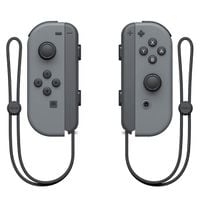Joy-Con
The Joy-Con is a controller for use with the Nintendo Switch console. Like the Wii U GamePad, the Joy-Con have near field communication functionality, specifically the right Joy-Con, allowing the use of amiibo with games. Additionally, the Joy-Con are equipped with "HD Rumble", a more advanced form of haptic feedback to replicate the feel of in-game activities.
The Joy-Con are unique in that they can be used as controllers regardless of whether or not they are physically connected to the Nintendo Switch. They can be connected to the Nintendo Switch itself when in Handheld Mode, forming something similar to the Wii U GamePad. They can also be disconnected from the Switch in Handheld or Docked Mode, functioning as wireless motion controllers; they can also be optionally be placed in the Joy-Con Grip, emulating the feel of a game controller. The left and right Joy-Con function as a pair in all of the aforementioned modes, but one can also use a single Joy-Con as a controller by holding it sideways.
The Joy-Con has similar latency to the Switch Pro Controller, experiencing lows of 93.7ms (5.6 frames) and highs of 112.86ms (6.8 frames). On average, however, it reaches around 103.33ms (6.3 frames), which is overall better than what the Switch Pro Controller can offer. However, its button size, joystick drift, and restrictions on being used as a pair in 8-Player Smash (because each Joy-Con registers as one controller even when used as a pair, while a Switch can only support eight controllers at a time) makes its competitive viability questionable.
As of the Nintendo Switch's Version 10.0.0 update on April 13th, 2020, the Joy-Con and Nintendo Switch Pro Controller can have custom button mapping via the system's settings, allowing more versatility beyond Super Smash Bros. Ultimate's Controls menu.
The Joy-Cons cameo in-game via the Robot Kit Mii Costume, referencing their usage in the Nintendo Labo games.
Standard controls in Super Smash Bros. Ultimate
Single Joy-Con (Left)
Note: From the perspective of the Joy-Con on its side
| Move | |
| Standard attacks | |
| Special moves | |
| Jump | |
| Grab | |
| Shield | |
| Taunt | |
| Pause | |
| Screenshot | |
| Nothing |
Single Joy-Con (Right)
Note: From the perspective of the Joy-Con on its side
| Move | |
| Standard attacks | |
| Special moves | |
| Jump | |
| Grab | |
| Shield | |
| Taunt | |
| Pause | |
| Home Menu | |
| Nothing |
Double Joy-Con
| Left |
Move |
| Standard attacks | |
| Special moves | |
| Right |
Stick-smash |
| Jump | |
| Grab | |
| Shield | |
| Taunt | |
| Pause | |
| Home Menu | |
| Screenshot | |
| Nothing |
In competitive play
The single Joy-Con is generally considered the worst official control scheme for Ultimate. It's small size and layout designed to be ergonomic when held upright with one hand make it unintuitive to be held on its side with both hands, especially for people with large hands. The shoulder buttons are also intentionally poor-quality and are difficult to press without an add-on that doubles as a wrist strap.
Double Joy-Cons have a much more positive reception. The handheld mode of the Nintendo Switch forced the hardware developers to include just as many buttons as other options, meaning every Smash input can be used without context sensitivity like controls in previous games. The ability to be used in tandem without a connecting wire like the Wii Remote and Nunchuk means the player can be in whatever position they want while playing, leading to a much more comfortable experience. While their small size is still an issue for some, these complaints are less prevalent due to the Joy-Cons being designed to be held in this fashion.
Gallery
Trivia
- The single Joy-Con is the only controller layout where clicking on the control stick serves a function; in this case, activating taunt in conjuntion with a directional button.
- Despite this, stick clicking cannot be configured as a button press on the Controls menu in Ultimate.
- The left Joy-Con by itself is also the only controller layout where the Minus button has a function in Ultimate, where it functions as Start.
- In Training Mode with a single Joy-Con, clicking the analog stick activates the Move List and doing so on the character selection screen will cycle palette swaps to the right (same as pressing the SR button).
| Controllers and buttons | |
|---|---|
| Nintendo 64 controller | |
| GameCube controller | |
| Wii Remote (and Nunchuk) | |
| Classic Controller | L |
| Nintendo 3DS | |
| Wii U GamePad / Pro Controller | L |
| Joy-Con | |
| Switch Pro Controller | L |
| Third-party controllers | Hori Mini Pad · Arcade controller · Keyboard |
| Other | Smash Controller · Controller modification |




